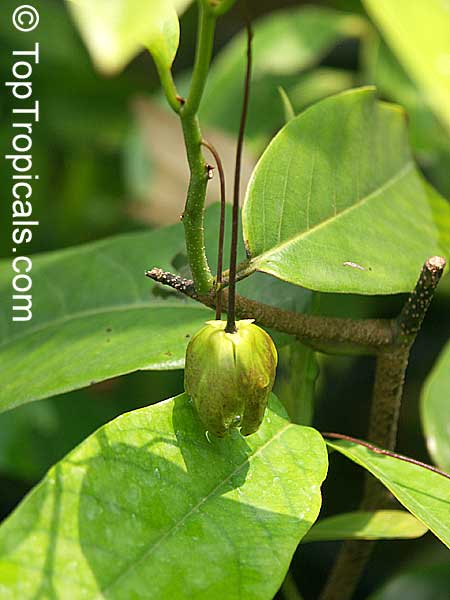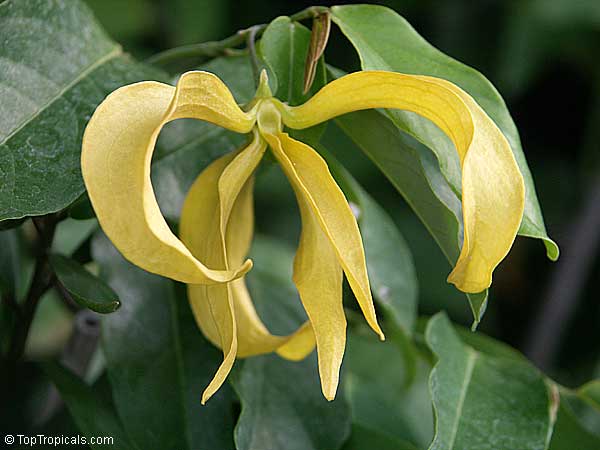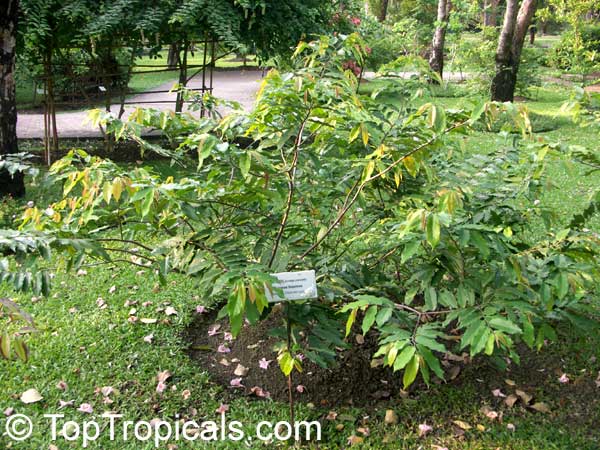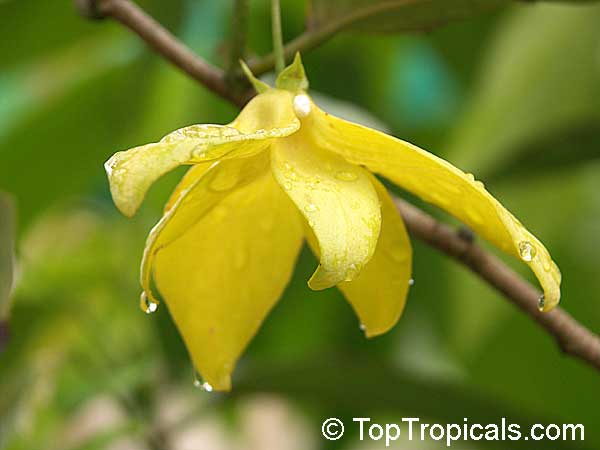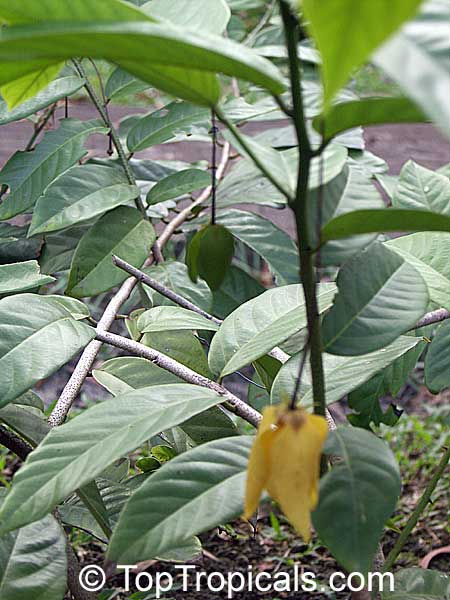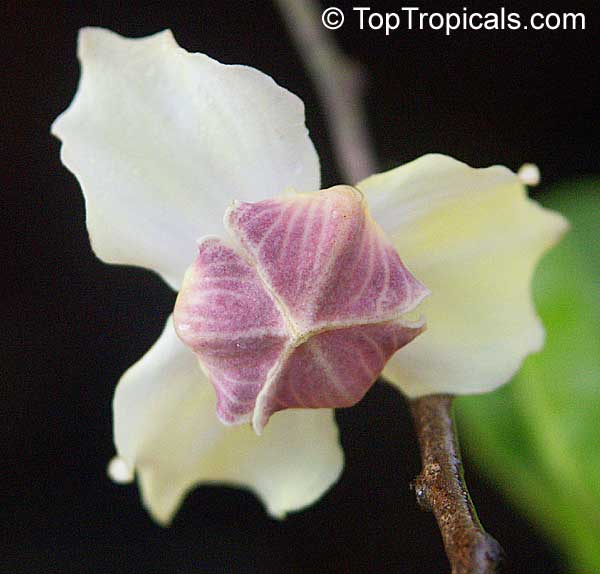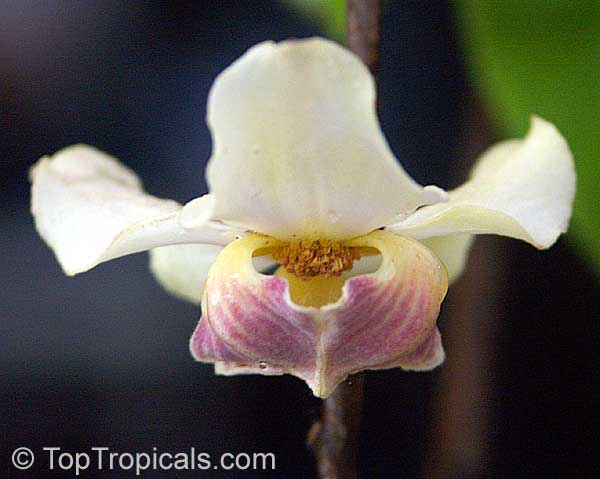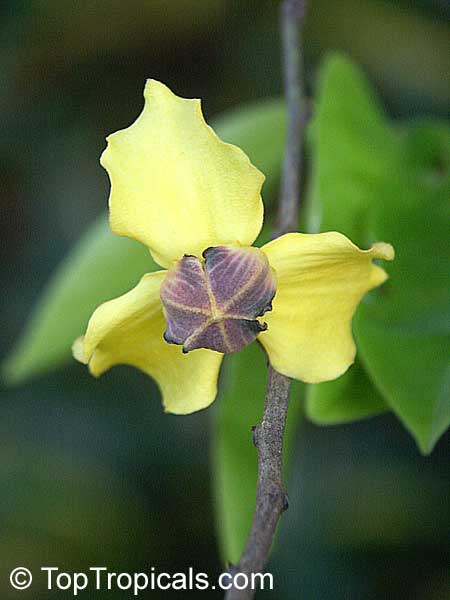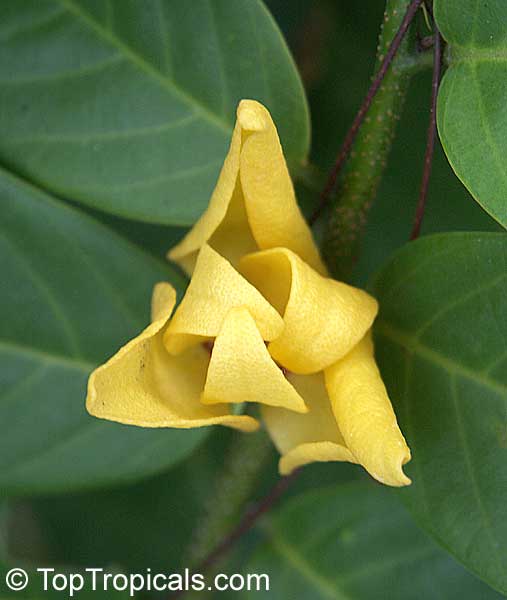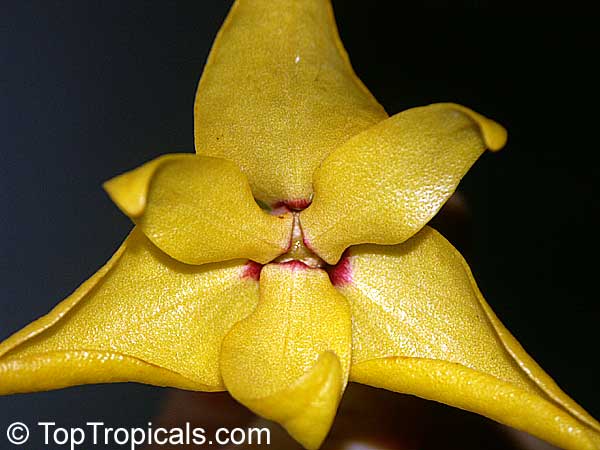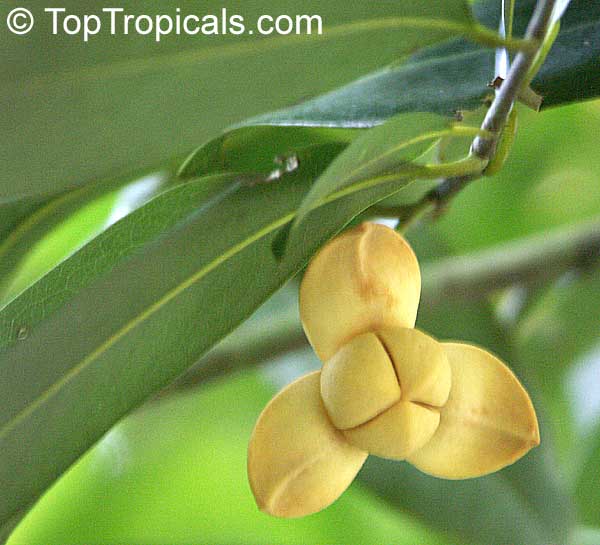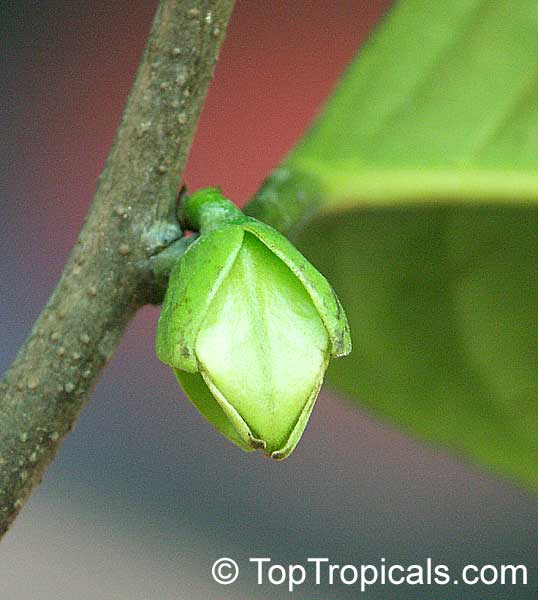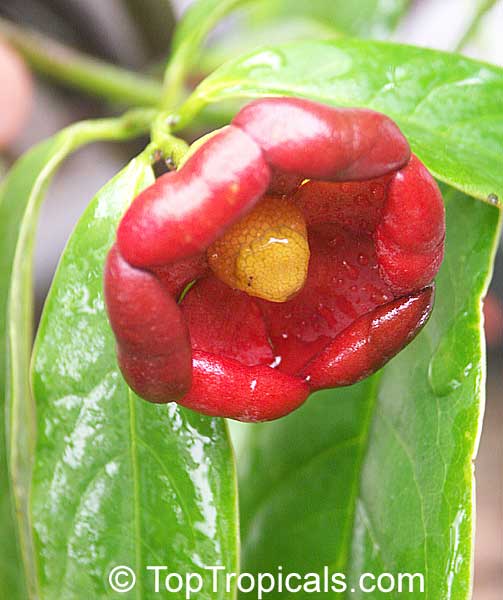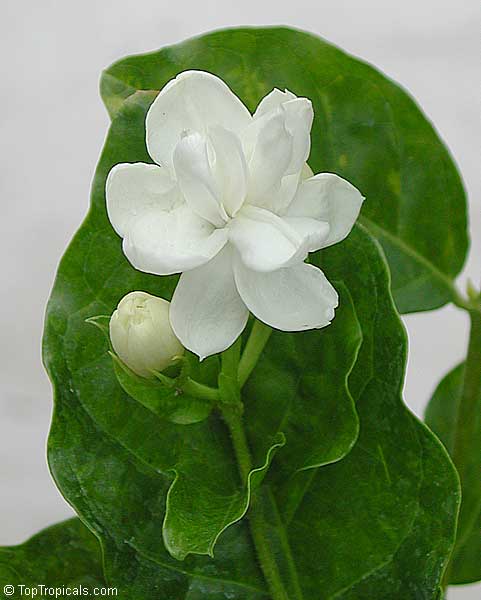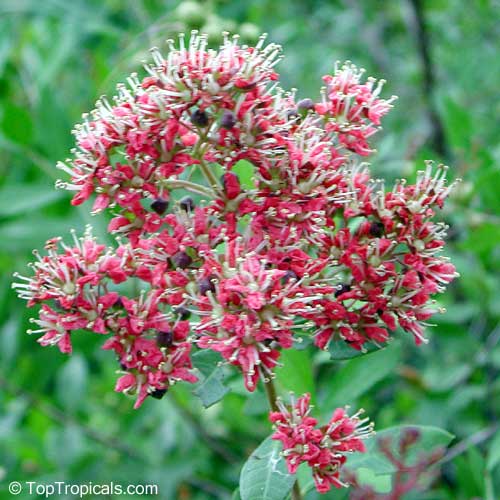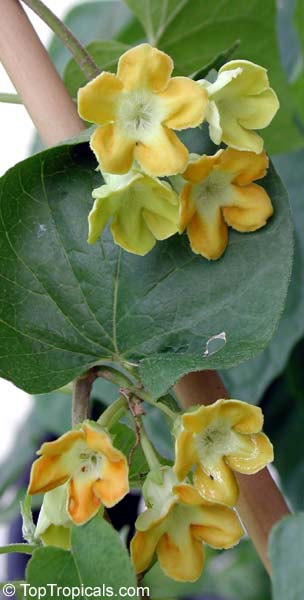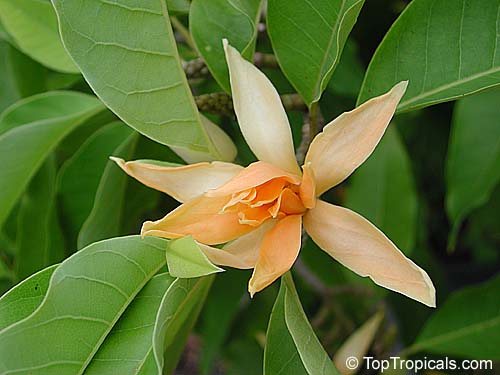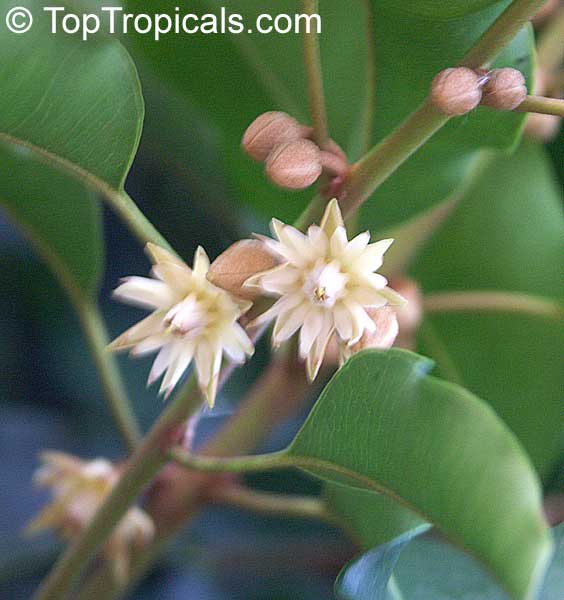Enchanted Aromas
Fragrant Plants of Annonaceae Family
By Alex Butova
Translated from Russian by Michelle Renee Healy
Discovering the magical aroma…
 Here we discover yet another extensive family of exceptional plants, these from the tropical and subtropical regions of southeastern Asia. Bearing the name Annonaceae, this family of many members includes 130 genera and around 2,300 species of the most diverse plants found anywhere on the planet, the majority of which are still discovered in their natural habitat to this very day.
Here we discover yet another extensive family of exceptional plants, these from the tropical and subtropical regions of southeastern Asia. Bearing the name Annonaceae, this family of many members includes 130 genera and around 2,300 species of the most diverse plants found anywhere on the planet, the majority of which are still discovered in their natural habitat to this very day.
Members of the Annonaceae family range from legitimately large trees down to bushes and lianas, many of which bear fruit that is not only edible, but truly delicious and even has medicinal uses. From the midst of all these treasures, make special note of one group; best known for its bewitching fragrance, this group of plants is among the top few in producing world-class aromas. But let's leave the fruit salad (however delightful it may be) on the table for just a minute while we get to know the fragrant Annonaceae a little bit better.
It should be stated right here that the plants that we are about to discuss further are all very closely related, many with only subtle, yet fascinating differences between them. It will be helpful to imagine yourself in the Far East, and you see before you a multifaceted heathen Goddess. Each of her faces is significantly different, and yet each shows a beautiful resemblance to the others. In the same way, each face in the Annonaceae family has its own unique characteristics.
The leaves of Annonaceae are simple, flat, and set in pairs up both sides of the long stems, and the floral stems bear up to large numbers of spirally arranged petals and pistils. All the flowering parts of the plants show a very clean-cut definition, as though their lines were laid down by the hand of an experienced artist. The stamens are very short, and each pistil contains one upper ovary with a single portion and a single parietal ovary; and there tend to be several such ovaries to each flower. The berry-like fruit develops from the ovary, but sometimes the ovaries coalesce, forming one large fruit from the many ovaries instead of individual small fruits. One example of this is the Sugar Apple (Annona squamosa), which is a member of this family. In this case, it is the sugar apple that does not fall far from the tree, since this plant has many excellent characteristics like the other Annonaceae. But above all else, it is the scent - that enchanting, elusive fragrance - which puts this group of plants in a class all of their own.
Plants of Annonaceae Family are propagated either by seeds of grafting/air-layering. Possibility of growing them from cuttings are unknown - cuttings are practically impossible to root. This is why many of these plants are very rare and hard to find.
The flower of all flowers…
At the forefront of all this Annonaceae splendor is, of course, Cananga odorata, better known as Ylang-Ylang (for more information please see the article and the book about this plant). It is a large tropical evergreen tree, whose height can reach up to 60 feet or even more. The golden blossoms adorning the descending branches have long, slightly twisting petals and an aroma whose presence is detectable from a distance of 30 feet and more. (Some people can smell the fragrance of this tree many yards away on a windy day).
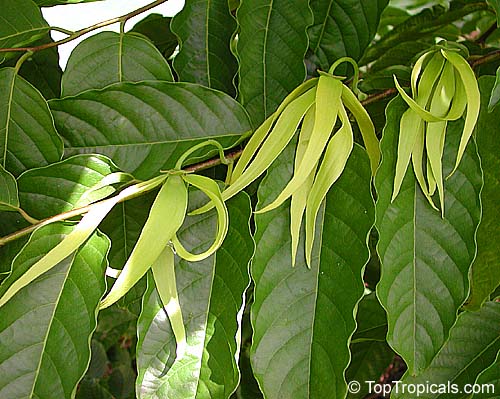 Cananga odorata finds its native habitat in southern China, Southeastern Asia, India, and the Island of Polynesia, where it grows everywhere - like a fragrant wildfire. Its local name, "Ylang-Ylang" (or more precisely, "alang-alang") signifies "the flower of all flowers"; and with its intoxicating, sensual aroma, it could not be better named. According to Indonesian folk custom, Ylang-Ylang awakens love, passion, and secret desire within a person. Indonesians use the freshly cut petals to decorate the bedrooms and sprinkle on the beds of newlyweds. The form and fragrance of these flowers is said to strengthen the respective charms of each partner, increasing their sexual energy and giving them hitherto unknown enjoyment. Ylang-Ylang is used to guarantee the complete bliss of the wedding night, which will then remain in the couples' memory for life. With its heady perfume, Ylang-Ylang plays the role of a mild aphrodisiac - its surprising aroma opens up the human heart and soul, leaving them defenseless before the strong wave of feelings which follows.
Cananga odorata finds its native habitat in southern China, Southeastern Asia, India, and the Island of Polynesia, where it grows everywhere - like a fragrant wildfire. Its local name, "Ylang-Ylang" (or more precisely, "alang-alang") signifies "the flower of all flowers"; and with its intoxicating, sensual aroma, it could not be better named. According to Indonesian folk custom, Ylang-Ylang awakens love, passion, and secret desire within a person. Indonesians use the freshly cut petals to decorate the bedrooms and sprinkle on the beds of newlyweds. The form and fragrance of these flowers is said to strengthen the respective charms of each partner, increasing their sexual energy and giving them hitherto unknown enjoyment. Ylang-Ylang is used to guarantee the complete bliss of the wedding night, which will then remain in the couples' memory for life. With its heady perfume, Ylang-Ylang plays the role of a mild aphrodisiac - its surprising aroma opens up the human heart and soul, leaving them defenseless before the strong wave of feelings which follows.
Ylang-Ylang is used widely in perfumery, in both the traditions of the East and in the commerce of the West. Ylang-Ylang lends its seductive soul to some of the most famous fragrances in the world, including "Chanel No. 5" and "Coco" from the renowned firm of Chanel; its aroma also constitutes the heart of "Aqua de Gio" from Giorgio Armani, "Poison" from Christian Dior and "Champs Elysee" from Guerlain, each of which is no less beloved worldwide in the chosen few of elite perfumes.
The world's finest Ylang-Ylang essential oil is produced in far Asia and northern India. The oil is produced by processing resin of styrax, from which the oil is pressed and crystallized, forming a unique crystallized essence. This method of making the essence draws from the depths of the ages - it is based on the traditional Ayurvedic principles of physical influence on a man's senses. This essence, with its overwhelming presence, serves as a method of romantic communication, as well as lifting stress, improving mood and increasing vitality.
 The ideal location for Ylang-Ylang is in full sun, but it also does fairly well in light shade, although it will not bloom as profusely. Large, healthy seedlings will bloom as soon as the third year, and the flowers gradually change from light green to lemon yellow, and maturing flowers become a dark golden color, flecked with brownish specks. The flowers with their long (about 2-2.5"), narrow, drooping petals would make a splendid adornment for evening dress. Thus nature herself gives us the real live "suspended queen" from Dumas' Three Musketeers.
The ideal location for Ylang-Ylang is in full sun, but it also does fairly well in light shade, although it will not bloom as profusely. Large, healthy seedlings will bloom as soon as the third year, and the flowers gradually change from light green to lemon yellow, and maturing flowers become a dark golden color, flecked with brownish specks. The flowers with their long (about 2-2.5"), narrow, drooping petals would make a splendid adornment for evening dress. Thus nature herself gives us the real live "suspended queen" from Dumas' Three Musketeers.
The Ylang-Ylang tree blooms practically year round, and it is always attractive with its clusters of flowers and dark green oval fruits. Completely mature fruit becomesblack, and unlike the edible Annonaceae, the fruits of Ylang-Ylang are not used as food. They are not harmful if eaten, but they are not especially tasty either, having an astringent if not unpleasant odor reminiscent of fir or juniper. But even when Cananga is not in bloom, it is nonetheless esthetically pleasing, its drooping branches with downward-pointing leaves somewhat resembling the silhouette of a fir tree.
Cananga odorata has one less admirable quality - it grows very rapidly and can be rather aggressive, as other trees and bushes planted nearby may find themselves mercilessly uprooted by this exotic beauty, rising as majestic and imperturbable as a goddess who nonchalantly surveys all that stretches beneath her fragrant crown. However, there is a dwarf form Cananga odorata var. Fruticosa which is rather a small tree or shrub suitable for container culture and having the same kind of perfume flowers, although with less strong scent.
Fragrant Relatives
The nearest relatives of this "flower of all flowers" are Cananga fruticosa, Artabotrys hexapetalus, Artabotrys siamensis, Desmos chinensis.
Cananga odorata
Cananga odorata var. Fruticosa, sometimes considered as a separate species Canaga kirkii, is a smaller form of Ylang-Ylang tree, and could even be called dwarfish. This small and fragrant tree, ranging in height from 3 to 8 ft, is beautiful in every aspect, from its naturally rounded crown shape to its wide green leaves (3-5") and dark green bark to the wonderful yellow flowers. These hang singly or in clusters of 3-6 flowers, with each blossom reminiscent of a tiny octopus, replete with "feelers". As with all canangas, the recently opened flowers are a greenish-yellow, but mature to a dark golden color. They also have a similar but less intense aroma to Cananga odorata, although it is still used both for perfume and folk remedies.
Notably, this is the species of Cananga used to produce the famous "Makassar oil", a crucial component of every Eastern ceremony. In Malaysia, for example, these flowers are considered an indispensable feature of burials, because they are believed to distract the mourners from their grief and bring pacification to the soul. Cananga fruticosa prefers moist but well drained soil and plenty of light. In shade it grows more rapidly, but has fewer branches and flowers, and is less hardy than when grown in full sun. This plant is greatly valued by floriculturists for its compact size and ability to be container-grown in climates not as hot and humid as its native environment. This is a prime example of the ideal exotic plant, introducing a sensual note into any garden or verandah. With good care, this tree flowers almost continuously year-round, with the most abundant blooms in spring and summer. It is usually propagated by air layering, and the air layers take root after two months.

Artabotrys
hexapetalus, the star of this Family from India, is known by the Indian names "Bhandari vine", "Manorangini", "Hara-champa", "Kantali champa", and also called Ylang-Ylang Vine. It is a woody liana or dense evergreen bush with glossy leaves, strewn with the most fragrant of flowers. Their color changes light green to canary yellow to (just like the Ylang-Ylang in its mature stage) a rich golden yellow. Artabotrys takes its own sweet time growing up, intertwining with everything in its path. It can be trained into the desired form and direction, including the form of a bush. Freshly cut and placed in water, Atabotrys flowers will grace the house for several days, filling it with their intoxicating aroma recembling sweet melon.
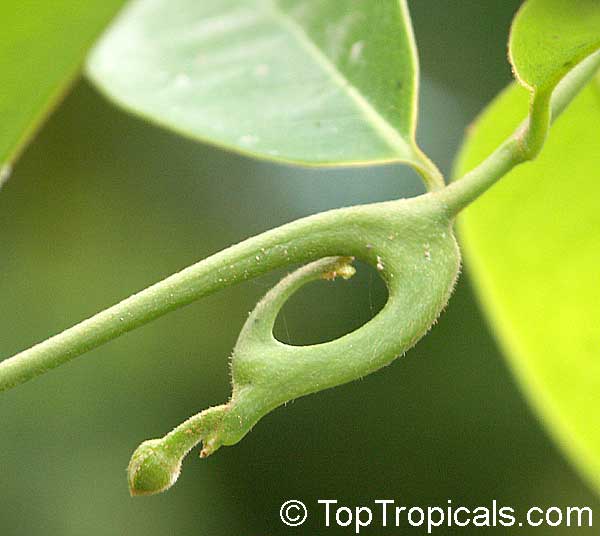
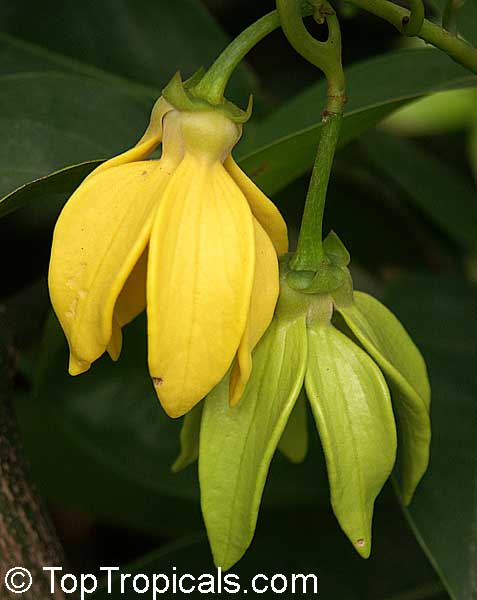
Artabotrys siamensis - the sister of hexapetalus, and the gift of distant Thailand (from Siam, the archaic name of this country). In the course of time, the flowers of this very attractive liana become intensively yellow, very fragrant, and their smell is strengthened toward the evening and remains an intoxicating presence all the way until dawn. It flowers year round, with the peak of its bloom is from January through March in warm climates.
Artabotrys is propagated by seed or by air layering, and the cuttings rapidly put forth roots and begin to grow. In its native soil of Thailand, Artabotrys grows in the open soil, and is frequently used to create a rapidly-growing living fence. If provided with a large enough container, it can also be grown that way.
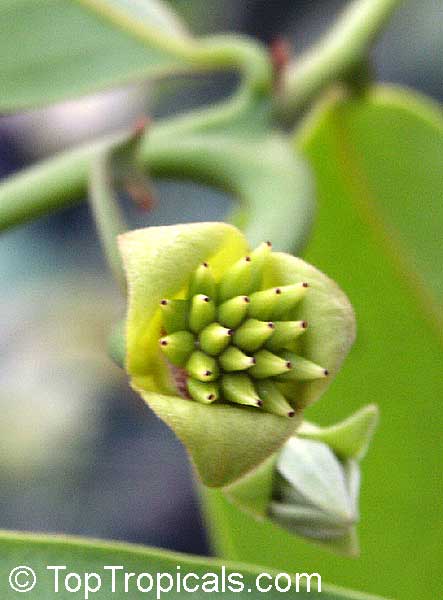
Desmos chinensis
Desmos chinensis is a miniature, twisted form of Ylang-Ylang. It forms a rounded, compact bush, reaching only 3-4 ft at most. Originating from India, its flowers appear from April until July and are distinctive with a clear note of lemon in their fragrance. Newly opened greenish flowers are unobtrusive among the foliage before developing into a beautiful yellow and then a rusty red before falling off. A wonderful candidate for indoor growing, Desmos chinensis gives connoisseurs a chance to bring a page from an Eastern fairy tale right into the rooms of their homes. It is especially ideal for those with limited indoor space, or for those who live in a colder climate, where growing such a beauty in the open ground would be impossible. This species also lends itself fairly well to training as a bonsai, which will gladden the home for many years with its lovely flowers and bewitching aroma.
Here is another fine example of a rare and fragrantly decorative plant - Goniothalamus. In nature these plants can be found in a variety of natural environments, from sea- level Bangkok to the mountains of northern Thailand at about 1200 meters above sea level, to the humid and nearly impenetrable jungles of Cambodia and Vietnam, to Borneo. Despite this wide range of habitats, it is difficult to find and even harder to grow. It's difficult, but by no means impossible! There are over fifty known varieties of this plant, the most popular of which are Goniothalamus macrophyllus, Goniothalamus laoticus (G. marcanii), Goniothalamus giganteus and Goniothalamus tapis, all of these wonderfully "tameable" by gardeners. All members of Goniothalamus are wonderfully fragrant, and Goniothalamus macrophyllus develops the form of a majestic candlestick reaching a height of 15 ft, with enormous 5-20" leaves, living up to its title - macrophyllus means "large-leaved". Its flowers bloom from March until May, with seeds developing between June and August. This plant can be grown from either seeds or air-layers, although seedlings grow very slowly, reaching only 4" in their first year, and may only bloom beginning in their fifth year. Making air-layers of this plant produces results much more quickly.
Gonithalamus laoticus
Goniothalamus laoticus (G. marcanii) is the rarest of its kind. It is very decorative, with beautiful golden yellow flowers overhanging from its branches. It blooms practically all year round, but the peak of flowering is from May-July, with fruits ripening in October. When Goniothalamus macrophyllus and Goniothalamus laoticus are grown from seed, they grow slowly and bloom late, and, if seeds are germinated in a constricted space, the blooms will be much smaller. This is why airlayering is the preferred method of propagating these plants. This type of goniothalamus is no lover of direct sun and high temperatures, but rather prefers fresh, humid air and moist soil. In the tropical forests of South Thailand, where the humidity reaches close to hundred percent, grows the surprising Goniothalamus giganteus. Its height reaches 60 ft, and has large yellow 3-5" flowers whose wavy lobes have a very strong, sweet, heavy smell. This giant in full bloom extends its aroma, which is easily detected from a distance. It acclimates rather well in the more northern zones; however, it flowers less abundantly than in its native jungle.
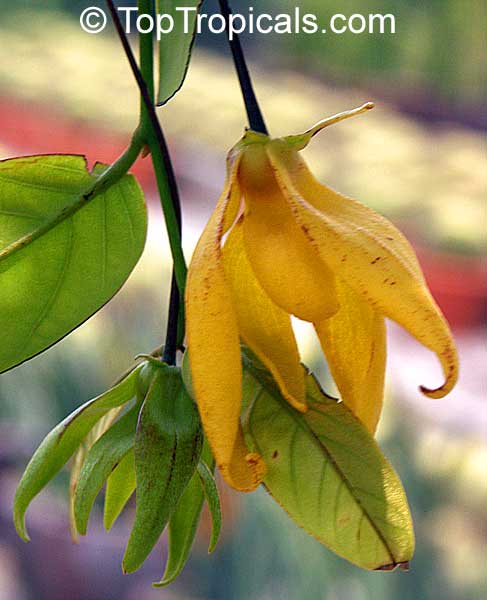
Goniothalamus tapis is a very suitable plant for cultivation under household conditions. It germinates easily enough from seeds, which are viable throughout the year, and layers take root in the course of 3-4 months. Goniothalamus tapis adapts wonderfully both in the garden and in the pot. However, in direct sun and dry conditions, its leaves can begin to show burning, twisting along the edges, and drying. This plant is remarkable: besides having strong, delicious aroma, it has large leaves, reaching 10" long and 2" cm wide; and comparatively small flowers of 1". These blossoms are like a constantly changing artist's canvas, going from a saturated yellow to a golden cream, and then taking on a pinkish nuance. In recent years scientists have been able to isolate the valuable chemical substance that has been shown to be useful in chemotherapy treatment of cancer.
As we speak about the therapeutic properties of fragrant Annonaceae family, one cannot fail to mention Melodorum fruticosum. This flower is the symbol of Thai province Itsisaket. It has smooth, dark green elongated leaves and the cream colored flowers with brownish tips, positioned on their 1" stems. The flowers have three outer petals, and the anthers and pistil are hidden within the embrace of three tightly clenched inner petals. In bloom, melodorum extends its aroma in a ring of sweet influence. Once dried, the flowers of Melodorum fruticosum are a mild stimulator of heart activity, and preparations made from them increases hemoglobin and help with muscle tone.
The Mitrephora genus totals more than 40 species consisting of small trees and shrubs, growing in a fairly wide geographical strip: from tropical Asia in the north up to the north of Australia in the South. The majority of these plants grow in the countries of Southeast Asia and Southern India. However, they have a wide circulation in the Philippines and Borneo as well.
The elaborate and fragrant flowers of Mitrephora vandaeflora resemble miniature six-pointed stars shining out from short, dense branches. The three outer petals have a magnificent crimson-orange color and a slightly twisting form. Three inner petals, located crosswise, are shorter and narrower at the base, but extend to the very edges of the flower. This beautiful plant blossoms from January till March. It lends itself to easy multiplication by cuttings and easily acclimates to room conditions. This plant is by all means a moisture-lover; however, when it finds itself in room conditions, it is capable of surviving in these relatively dry conditions.
Mitrephora winitii - this interesting, well branched tree features smooth, dark brown bark ornamented by intricate gray-green patterning. Young seedlings are densely covered by fuzzy down. Leaves are roundish, dense, have a brilliant dark green finish and matte pale-green underside. This plant differs in its unique flowers: three snow-white external 2" petals surround three inner 1/2" petals, bright with splashes of pink-to-purple colors on a white background. The plant is a typical endemic - it is found only in the north of Thailand, in sufficiently dry zones, and grows on open stony or calcareous hills covered by evergreen thickets, at heights of 300-400 ft. The local name of this surprising flower is Maha Phom.
Mitrephora wangii very much resembles Mitrephora winitii, except that it can grow taller. It has a smooth bark, devoid of patterns. The oblong leaves are glossy from above, with the undersides covered by fine hairs. The flowers possess a creamy-yellow shade, and are sometimes single, but are usually collected in inflorescences with 2-3 flowers in each. The form of the flowers is also similar to Mitrephora winitii: they have three wide outer petals with wavy edges, with the sides covered by a fine down. Three small internal petals, remind the observer of the claw or the beak of an exotic bird. This lovely plant blossoms in February-March. It is often found in China and in the north of Thailand where it grows in lower-altitude forests.
And, at last, Mitrephora sp. 'Ciang Rai ' - the most rare of all this family, is also endemic. It makes its home only in the province of Chiang Rai. Its 5-7 cm flowers boast dazzling white outer petals fading to a sunny yellow at their borders.
Mitrephora vandaeflora
Monodora myristica
Monodora myristica - a unique representative of the family Annonacae, this plant comes from Africa. It is known by various names, including the African Muscat Orchid (African Orchid Nutmeg), the Jamaican Nutmeg, and the Calabash Nutmeg. By these names it is easy to guess that this plant is used as a substitute for nutmeg. It showcases large leaves, and on long pedicels hanging down among them peek out absolutely surprising flowers similar to orchids or strange tropical butterflies. The three inner petals are yellow with pale purple specks, and the edges of the three external yellow petals are edged in magnificent speckled ruffles. When the buds are still closed, the closed yellow-purple internal petals are decorated by densely pressed external petals, with their velvety frills. The fruits are reminiscent of a baseball, and contain oily edible seeds. Flowers and seeds have the rich aroma of nutmeg. The roasted seeds are used in cookery as a garnish. Fresh seeds and roots are used medicinally as a remedy for headache and toothache, respectively.
Monodora myristica
Melodorum is a small tree, related to the ylang-ylang. It is successfully grown in containers and is easy in care, blooming from spring till fall. Despite their plainness, the flowers of Melodorum distribute their fine perfume to great distances. It is for this that Asian gardeners include it with pleasure among their favorite garden plants. This plant can tolerate some shade; however, the lack of sunlight adversely affects flowering.
Melodorum siamensis (Rauwenhoffia siamensis) which is known in its native Thailand as Nom Maew, has small, greenish, very fragrant flowers, narrow leaves and drooping branches. It is an essential ingredient in a famous Indonesian herbal concoction which includes, besides Melodorum, ginseng root, powdered corn, etc. This tincture contains essential oils, pectin, carbohydrates, three-terpene glycosides, saponides and other useful substances. It possesses a pleasant taste and aroma, and offers a variety of benefits: it improves muscle tone, expands circulation, reduces blood pressure, restores an regular heart rhythm, increases red blood cell count, reduces pain and fatigue, cleanses the body of toxic substances and stimulates intellectual activity.
Uvaria - one of the largest groups in the family Annonaceae, contains approximately 150 species. It is found in nature in Southeast Asia, Malaysia, on the Java islands, in Sumatra and Borneo, in the Philippines, in New Guinea and even occasionally in New Zealand. Most are small trees or shrubs, but some vining varieties will cling to a support. The majority of varieties have much in common, preferring the damp jungle where they can reach impressive sizes. In the continental part of Southeast Asia uvarias are found growing in evergreen woods or on river banks at heights from up to 3000 ft above sea level.
Melodorum siamensis
Uvaria lurida. Bright red waxlike flowers of this small tree have an unusual cuplike form, appearing as though molded of wax or plastic.
Uvaria rufa (Unona grandiflora)– a very rare plant with remarkable flowers. It is a compact bush or tree, growing in height up to 5-6 meters. Its long, rounded, leathery leaves with very short stems and fuzzy undersides are very decorative. The dark red flowers, changing from red to yellow at the center, look like huge daisies. This plant attracts butterflies, bees and humming-birds with its pleasant aroma. After flowering fleshy red fruits are formed. Uvaria rufa may be grown on walls or in containers. It starts to blossom at a young age, tolerates irregular watering and can stand a little shade, though it prefers full sun. The bark of Uvaria rufa contains active alkaloids, and affects the parasympathetic nervous system. The roots of the plant are also used in folk remedies.
These are some sketches of the portrait of our many-faced Asian Goddess, but what words can truly describe her? Even so, don't be afraid that it will be too difficult to bring your favorite version of these fragrant beauties to your own home or garden. Everyone can grow one of these real-life eastern fairy tales for themselves!
The world filled with aromas
There is nothing more ephemeral than a fragrance. In the depths of centuries and even millenia attempts to keep the fleeting pleasure of smells have been lost. The art of the preservation of aromas is called Perfumery. Still laden with the mystique of ancient times, perfumery came to Europe from the East in the Middle Ages. Europeans were first acquainted with this luxury during the Crusades, when Christian knights fought the Muslims of the Near East to win the site of Christ's tomb. And, despite the gloomy custom of the Middle Ages, with its refusal of any worldly vanity and pleasure, the caravans carrying fragrant water to Europe pleased the medieval nobility. Even by the early Renaissance, the first especially skillful masters of the art were brought to Europe on "The Road of Aromas". The word "perfumery" is derived from "?ar Fume" ("through a smoke") from which is possible to draw the conclusion that the most ancient way to keep a smell was manufacturing aromas in the form of incense which were then released by burning. These slowly burned down, distributing the fragrant smoke all around.
From historical sources it is known that art of manufacturing fragrances arose in China and India and only recently has been further developed. The industry still has the unique style inherent in each of the traditional perfumery schools of the East. For thousands of years, there were only three ways that were used to preserve fragrances. These were the forms of solid incense; liquid - flavored spirits, scented water, colognes, etc; and sachets - soft small pillows filled with dried plants and used to scent water, food, clothes, linen and other things.
Jasminum sambac
Lawsonia inermis
During ancient times in the East the use of fragrant incense was authorized only at the performance of ritual ceremonies, and only nobility had the right to use liquid perfumes. Even the production of spirits only took place in palaces. It was said of aristocrats: "the place of their stay can be determined by the smell - it gets even through walls".
The major components of ancient spirits were extracts from vegetable and animal substances. The basic animal substance was oil derived from predatory mammals of southeast Asia, and also musk. These animal oils were used to preserve the scents of the flowers of the East. There is an ancient legend that medieval Bagdad, which was at that time the center and soul of the Arabian world, received the name "City of a thousand aromas", and that at the construction of its palaces and mosques mixes of perfumes and lime were used. These foundations exhaled their aroma for many years.
One of secrets to preserving a smell is a skill is the art of collecting the flowers during the correct time of day. Ancient master-perfumers knew perfectly, at what time of day each flower was at its peak, and used this knowledge for gathering fragrant plants. Perfume in the form of incense was produced by burning, in a special vessel, a fragrant mix consisting of a fine powder of the fragrant parts of plants, from pitches, gum, essential oils, etc.
And in the East and in Europe special small pillow-sachets, sewn from thin fabric, were filled with a mix of scented flowers, and enjoyed widespread popularity. They were used as a gift on holidays such as weddings or birthdays. In France to this day sachets are placed in linen cases, so that the linen becomes impregnated with a subtle but fine smell. And in Asia two kinds of sachets are made: fresh and dry. In addition to sachets fragrant ingredients can be placed in a small basket, or in a headdress or fan.
Telosma minor
Michelia champaca
According to eastern traditions, the smell makes a sachet not merely a pleasant gift, but also an original amulet having sacred value. According to Buddhist beliefs, the number nine brings a person happiness and well-being. Therefore, a correct recipe recipe should include the aromas of nine various flowers. The most popular until now have the classical recipe consisting of Jasmine (Jasminum sambac), Ylang-Ylang (Cananga odorata), Henna (Lawsonia inermis), Primrose (Telosma minor), roses (Rosa sp.), Champaka (Michelia champaca), Glory Vine (Faradaya splendida), Pandanus (Pandanus odoratissimus) and Bakul Tree (Mimusops elengi).
The ancient ways of manufacturing fragrances the Europe, and the unusual life of an equally unusual person and his search for identity through fragrance is found in Patrick Suskind's book Perfume.
In our century of industrial technologies, traditional ways of preparing perfumes have since been superseded by progressive methods of chemical processing, and vegetable ingredients have been replaced by the creation of synthetic fragrances. The majority of the ancient original recipes of spirits and the invaluable art of correctly preparing aromas have gradually and irrevocably been lost. The secrets of the old masters were kept in oral tradition, meaning that may of these secrets are now forever silent.
Smell renders a huge influence on our emotions. Scientists have established the connection between smells and the trigger mechanism of memory located in the frontal lobe of the brain. They are also studying the effects of pheromones - fragrant substances which serve as sources of physical appeal. According to theory, personal appeal or repel is caused by the inherent scent of the organism. If any organism-plant or animal - loses its scent, it also loses it appeal to possible mates. The human body also is supplied with special glands, which produce our own individual smell. This can vary depending on the condition of our health and emotional state.
Pandanus odoratissimus
Mimusops elengi
Scents mean more to us than we realize. The natural smell of real flowers, essential oils, and complex perfumes represent much more than simply pleasant smells. Smells can stimulate a good state of health or can conversely cause discomfort. If you are having a bad day, stress at work, or simply a melancholy mood, just inhaling a whiff of certain aromas can instantly lift your mood and improve your spirits!
The study of smells and their influence on the human state of health and emotion is also the realm of professional psychologists. Scents are even used to bring a sense of fulfillment to shoppers in stores. Owners of large Japanese companies use, besides high-end technologies, aromatization of the workplace in their enterprises to increase productivity and optimize production. In the morning workrooms are filled with the invigorating smell of lemon, during a lunch break it is replaced with the aroma of roses promoting relaxation, and for evening the workers are invigorated by the fresh smells of a forest.
But, however skillfully made, these "canned" aromas will never be able to replace the value of and intimate dialog with a plant which you yourself have grown, and which blossoms and releases it fragrance just for you- for the person on whom it relies on for life. Its fragrance will allow you to feel that harmony which is initially incorporated in the divine design of our world, a harmony without which the Earth would simply be an ice block carried in the infinity of open space. And it is not important whether you sit in a chaise lounge under the hot southern sun or are warmed a fireplace, looking on a cold landscape from behind a window- plan yourself a small personal holiday by planting a fragrant flower, and let it be the best kind of talisman- one which will bring happiness and love to your house.


